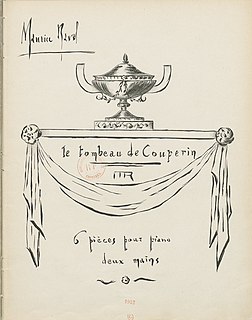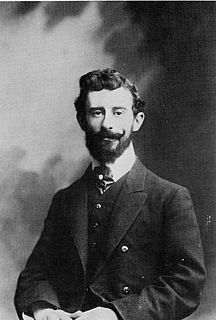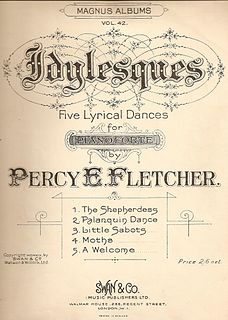Related Research Articles
Johann Pachelbel was a German composer, organist, and teacher who brought the south German organ schools to their peak. He composed a large body of sacred and secular music, and his contributions to the development of the chorale prelude and fugue have earned him a place among the most important composers of the middle Baroque era.

Charles-Marie Jean Albert Widor was a French organist, composer and teacher, most notable for his ten organ symphonies.
A suite, in Western classical music and jazz, is an ordered set of instrumental or orchestral/concert band pieces. It originated in the late 14th century as a pairing of dance tunes and grew in scope to comprise up to five dances, sometimes with a prelude, by the early 17th century. The separate movements were often thematically and tonally linked. The term can also be used to refer to similar forms in other musical traditions, such as the Turkish fasıl and the Arab nuubaat.
A prelude is a short piece of music, the form of which may vary from piece to piece. The prelude may be thought of as a preface. While, during the Baroque era, for example, it may have served as an introduction to succeeding movements of a work that were usually longer and more complex, it may also have been a stand-alone piece of work during the Romantic era. It generally features a small number of rhythmic and melodic motifs that recur through the piece. Stylistically, the prelude is improvisatory in nature. The prelude also may refer to an overture, particularly to those seen in an opera or an oratorio.

The Toccata and Fugue in D minor, BWV 565, is a piece of organ music written, according to its oldest extant sources, by Johann Sebastian Bach (1685–1750). The piece opens with a toccata section, followed by a fugue that ends in a coda. Scholars differ as to when it was composed. It could have been as early as c. 1704. Alternatively, a date as late as the 1750s has been suggested. To a large extent, the piece conforms to the characteristics deemed typical of the north German organ school of the Baroque era with divergent stylistic influences, such as south German characteristics.

A piano concerto is a type of concerto, a solo composition in the classical music genre which is composed for a piano player, which is typically accompanied by an orchestra or other large ensemble. Piano concertos are typically virtuoso showpieces which require an advanced level of technique on the instrument, including melodic lines interspersed with rapid scales, arpeggios, chords, complex contrapuntal parts and other challenging material. When piano concertos are performed by a professional concert pianist, a large grand piano is almost always used, as the grand piano has a fuller tone and more projection than an upright piano. Piano concertos are typically written out in music notation, including sheet music for the pianist, orchestra parts for the orchestra members, and a full score for the conductor, who leads the orchestra in the accompaniment of the soloist.

Toccata is a virtuoso piece of music typically for a keyboard or plucked string instrument featuring fast-moving, lightly fingered or otherwise virtuosic passages or sections, with or without imitative or fugal interludes, generally emphasizing the dexterity of the performer's fingers. Less frequently, the name is applied to works for multiple instruments.

Le Tombeau de Couperin is a suite for solo piano by Maurice Ravel, composed between 1914 and 1917. The piece is in six movements, based on those of a traditional Baroque suite. Each movement is dedicated to the memory of a friend of the composer who had died fighting in World War I. Ravel also produced an orchestral version of the work in 1919, although this omitted two of the original movements.
Suite for Microtonal Piano (1978) is a suite for specifically microtonally tuned piano(s) by Ben Johnston written in 1977. According to Bob Gilmore the piece, "take[s] extended just intonation well beyond the point reached by Harry Partch."
Johann Jakob Froberger was a German Baroque composer, keyboard virtuoso, and organist. Among the most famous composers of the era, he was influential in developing the musical form of the suite of dances in his keyboard works. His harpsichord pieces are highly idiomatic and programmatic.

E-flat minor is a minor scale based on E♭, consisting of the pitches E♭, F, G♭, A♭, B♭, C♭, and D♭. Its key signature consists of six flats. Its relative key is G-flat major and its parallel key is E-flat major. The direct enharmonic equivalent of E-flat minor is D-sharp minor, a key signature of six sharps.

Sonatine is a piano work written by Maurice Ravel. Although Ravel wrote in his autobiography that he wrote the sonatina after his piano suite Miroirs, it seems to have been written between 1903 and 1905. He most likely referred to the dates he finished both of the works.
The Toccata in D minor, Op. 11 is a piece for solo piano, written by Sergei Prokofiev in 1912 and debuted by the composer on December 10, 1916 in Petrograd. It is a further development of the toccata form, which has been used by composers such as Johann Sebastian Bach and Robert Schumann. Other composers of well-known toccatas include Maurice Ravel, Dmitri Kabalevsky and Aram Khachaturian.
Aram Khachaturian's Piano Concerto in D-flat major, Op. 38, was composed in 1936. It was his first work to bring him recognition in the West, and it immediately entered the repertoire of many notable pianists.
Suite gothique, Op. 25 is a suite for organ composed by Léon Boëllmann in 1895.
Franz Schubert's Piano Sonata in C major D. 840, nicknamed Reliquie upon its first publication in 1861 in the mistaken belief that it had been Schubert's last work, was written in April 1825, whilst the composer was also working on the A minor sonata, D. 845 in tandem. Schubert abandoned the C major sonata, and only the first two movements were fully completed, with the trio section of the third movement also written in full. The minuet section of the third movement is incomplete and contains unusual harmonic changes, which suggests it was there Schubert had become disillusioned and abandoned the movement and later the sonata. The final fourth movement is also incomplete, ending abruptly after 272 bars.

Percy Eastman Fletcher was a British composer of classical music, born in Derby. He worked as musical director at London theatres including the Drury Lane Theatre and, from 1915 onward, His Majesty's Theatre. Besides, he wrote ballads, works for chorus, and suites for light orchestra, organ voluntaries for church use, as well as pieces commissioned for brass band competitions, including the tone poem Labour and Love used by the Irwell Springs Band to win the 1913 National Championships. This piece is often regarded as a significant moment in the development of the modern brass band movement and repertoire. It was followed by 'An Epic Symphony', used as the test piece for the Championship Section of the National Championships in 1926.

Pour le piano, L. 95, is a suite for solo piano by Claude Debussy. It consists of three individually composed movements, Prélude, Sarabande and Toccata. The suite was completed and published in 1901. It was premiered on 11 January 1902 at the Salle Érard, played by Ricardo Viñes. Maurice Ravel orchestrated the middle movement.

The Symphony No. 2 in E minor, is one of the Armenian composer Aram Khachaturian's most well-known pieces of music. Completed in 1944, it was nicknamed The Bell or Symphony with Bells by Georgi Khubov for its bell motif that begins and ends the piece. A typical performance lasts about 50 minutes.
